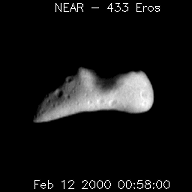 |
Department of Physics | AstroLab |
Asteroid Light Curve
The smaller asteroids in the Solar System are known to be non-spherical and rotating with periods in the range of a few hours to several days. As the asteroid rotates, as seen from the Earth, the observed cross-section changes causing the observed brightness to change.

The aim of the project is to measure the brightness variation of an asteroid in order to determine its rotation period. The shape of the light curve also reflects the three dimensioanl shape of the asteroid, and through forward modelling, the shape can be determine. An example of the type of result that can be achieved is shown below. This figure shows the reconstructed 3D model of 337 Devosa (top) in projection from five angles, together with the light curve data, and the best-fit light cuvre. The light cuvre was derived from observations over approximately eight weeks in 2019. The period has been folded about the period of 4.655 hours.

A moderately bright asteroid with a known short period (typically about 4 to 5 hours) that is well placed during the term can be targeted. The data taken on each night can be merged using the supplied "fast_solve" routine that effectively uses phase dispersion minimisation to find the period and to determine the run zero-point offsets. The amplitude range can be used to derive some basic shape information about the asteroid.
Project Details Project References
| Back to the AstroLab Home Page |